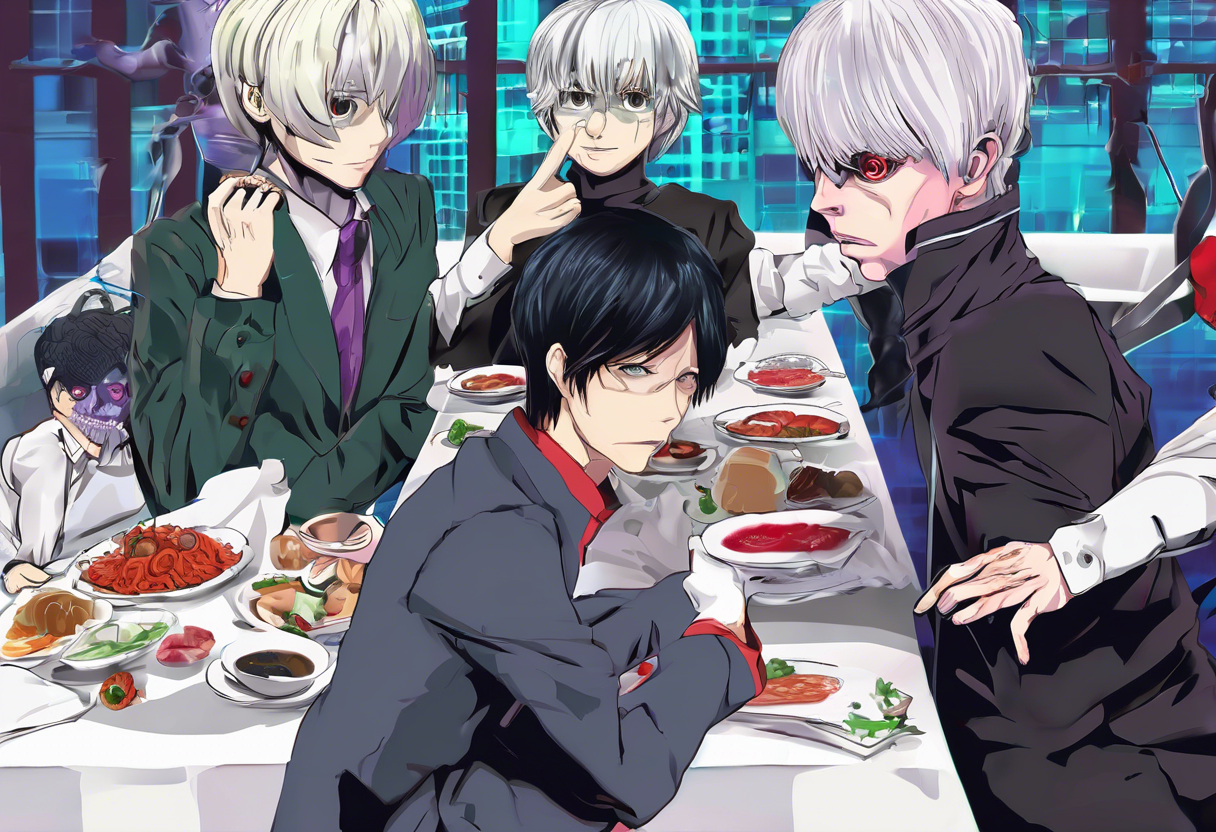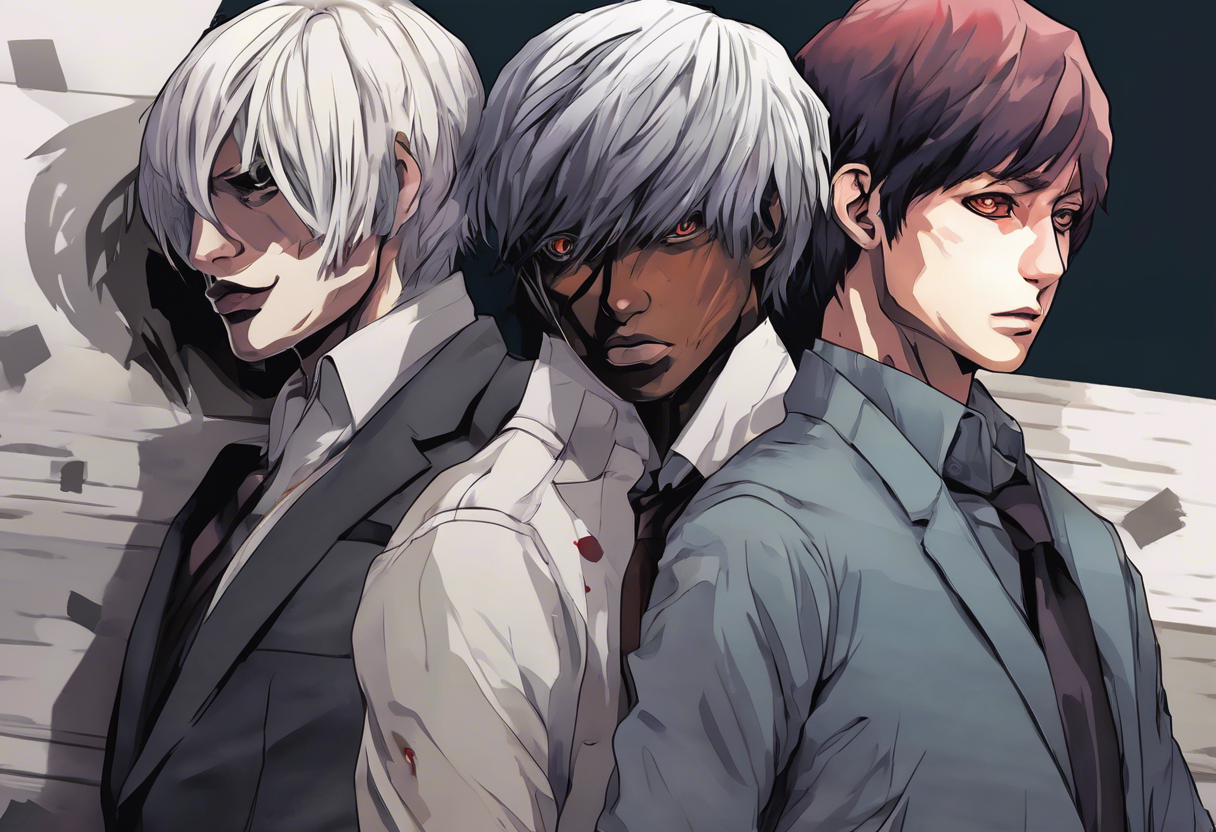Contents
Tokyo Ghoul – Episode 4: Supper
Introduction
"Tokyo Ghoul – Episode 4: Supper" is a pivotal episode in the anime series "Tokyo Ghoul," which is based on the manga of the same name by Sui Ishida. The episode was produced by Pierrot, a renowned anime production studio, and was directed by Shuhei Morita. The series’ writer, Chūji Mikasano, played a crucial role in adapting the manga’s narrative for the screen. Initially released in 2014, "Supper" stands out within the dark fantasy genre for its intense and thought-provoking exploration of human and ghoul relationships.
"Tokyo Ghoul" itself is set in a world where ghouls, supernatural beings that feed on humans, live among humans in secret. The series delves into themes of identity, morality, and the struggle for coexistence between these two species. Episode 4, "Supper," is particularly notable for its dramatic escalation of tension and its deep dive into the darker aspects of ghoul society.
Plot Summary
In "Tokyo Ghoul – Episode 4: Supper," Ken Kaneki, the protagonist, finds himself entangled in a perilous situation that tests his newfound identity as a half-ghoul. The episode begins with Kaneki’s daily life at Anteiku, a coffee shop that serves as a front for ghouls. Despite his efforts to adjust to his new life, Kaneki is still grappling with the aftermath of his transformation and the loss of Rize Kamishiro, the ghoul who turned him.
Kaneki’s life takes a drastic turn when he is befriended by Shuu Tsukiyama, a charismatic and affluent ghoul known for his refined tastes and sinister intentions. Tsukiyama, also referred to as "Mr. MM" due to his unique and sadistic appetites, invites Kaneki to his mansion under the guise of discussing literature and sharing a meal [2][3].
Unaware of the danger lurking ahead, Kaneki accepts the invitation and is treated to a luxurious setting, complete with fine dining and elegant attire. However, this facade quickly crumbles as Kaneki finds himself in a giant amphitheater-like arena, surrounded by ghouls adorned in masks and formal attire. Tsukiyama reveals that Kaneki is the main course for the evening, a rare delicacy due to his half-ghoul status [3][5].
The scene descends into chaos as a giant, grotesque ghoul named Taro is unleashed to capture and dissect Kaneki. The crowd of ghouls, eager for the spectacle, watches with anticipation as Kaneki struggles to survive. Despite his initial helplessness, Kaneki manages to tap into his inner ghoul powers, summoning the strength to fend off Taro. This display of power only heightens the ghouls’ excitement, with Tsukiyama intervening to save Kaneki from the crowd, intending to claim him as his own personal meal [3][5].
Throughout the episode, the tension is palpable as Kaneki navigates this treacherous world. His interactions with Tsukiyama and the other ghouls highlight the complexities of ghoul society, where individuals like Tsukiyama wield significant power and influence. The episode also touches on the themes of identity and belonging, as Kaneki struggles to find his place in a world where he is neither fully human nor fully ghoul.
The setting of the episode, particularly the opulent and macabre dinner party, serves as a backdrop to explore the darker aspects of ghoul culture. The use of masks and formal attire by the ghouls adds a layer of irony, contrasting their refined appearances with their brutal and cannibalistic nature. This dichotomy underscores the series’ exploration of the duality of human and ghoul existence.
As the episode concludes, Kaneki is left in a state of terror and confusion, facing the harsh reality of his new world. Tsukiyama’s true intentions are revealed, and Kaneki must confront the possibility of becoming a meal for this sadistic ghoul. The cliffhanger ending sets the stage for further conflicts and character developments in subsequent episodes.
Themes and Symbolism
"Tokyo Ghoul – Episode 4: Supper" delves into several central themes that are pivotal to the series. One of the most prominent themes is the exploration of identity and belonging. Kaneki’s struggle to find his place in both human and ghoul societies is a recurring motif. His transformation into a half-ghoul leaves him in a liminal state, where he does not fully belong to either world. This theme is symbolized through Kaneki’s interactions with Tsukiyama, who represents a segment of ghoul society that is both fascinated and repelled by Kaneki’s unique status.
Another significant theme is the critique of societal norms and the facade of civility. The dinner party hosted by Tsukiyama is a stark example of this, where ghouls don masks and formal attire to conceal their true nature. This juxtaposition of refinement and brutality highlights the series’ commentary on the superficiality of societal norms and the darker aspects that lie beneath.
The episode also explores the theme of power dynamics and the exploitation of the vulnerable. Tsukiyama’s character embodies the corrupting influence of power and the dangers of unchecked desire. His treatment of Kaneki as a delicacy underscores the series’ exploration of how those in positions of power often exploit and manipulate others for their own gratification.
Symbolically, the arena where Kaneki is to be served as the main course represents a microcosm of the larger world of "Tokyo Ghoul." It is a space where the ghouls’ true nature is revealed, and the rules of human society do not apply. This setting serves as a metaphor for the hidden world of ghouls, where they operate outside the boundaries of human law and morality.
Cultural Impact
"Tokyo Ghoul – Episode 4: Supper" has had a significant cultural impact since its release. The episode’s intense and graphic content sparked discussions about the boundaries of anime and the portrayal of violence and cannibalism. The series, including this episode, has influenced other works in the dark fantasy genre, contributing to a broader exploration of complex moral themes in anime.
The episode’s reception was marked by both praise and criticism. Fans of the series appreciated the episode’s dramatic tension and the deepening of the narrative, while others were disturbed by the graphic nature of the content. Despite these mixed reactions, "Supper" remains a pivotal episode in the series, widely discussed and analyzed within anime communities.
Critical Reception
Critically, "Tokyo Ghoul – Episode 4: Supper" was met with a mixed response. Many critics praised the episode for its intense storytelling and the development of Tsukiyama’s character, who is often cited as one of the most compelling villains in the series. However, some critics felt that the episode’s graphic content was excessive and detracted from the overall narrative.
Audiences were similarly divided, with some appreciating the episode’s bold approach to storytelling and others finding it too intense or disturbing. Despite these differing opinions, the episode is widely regarded as a turning point in the series, marking a significant escalation in the stakes and the complexity of the characters’ situations.
Legacy
"Tokyo Ghoul – Episode 4: Supper" continues to be a significant episode in the anime series, influencing both filmmakers and audiences. Its exploration of dark themes and its bold storytelling have set a precedent for other anime series to delve into complex moral narratives.
The episode’s impact on popular culture is evident in its references and adaptations in other media. The character of Tsukiyama, in particular, has become iconic within the series, symbolizing the dangers of unchecked power and desire.
In conclusion, "Tokyo Ghoul – Episode 4: Supper" is a landmark episode that contributes significantly to the narrative and thematic depth of the "Tokyo Ghoul" series. Its enduring relevance lies in its ability to provoke thought and emotion, making it a memorable and impactful part of anime history.
References
- https://tokyoghoul.fandom.com/wiki/Episode_4
- https://www.imdb.com/title/tt3897660/
- https://triptychalessandro.wordpress.com/2014/08/21/tokyo-ghoul-episode-4-review-supper/
- https://viscountxela.wordpress.com/2014/07/31/review-tokyo-ghoul-episode-4/
- http://tenchithoughts.blogspot.com/2014/08/tokyo-ghoul-episode-4.html







